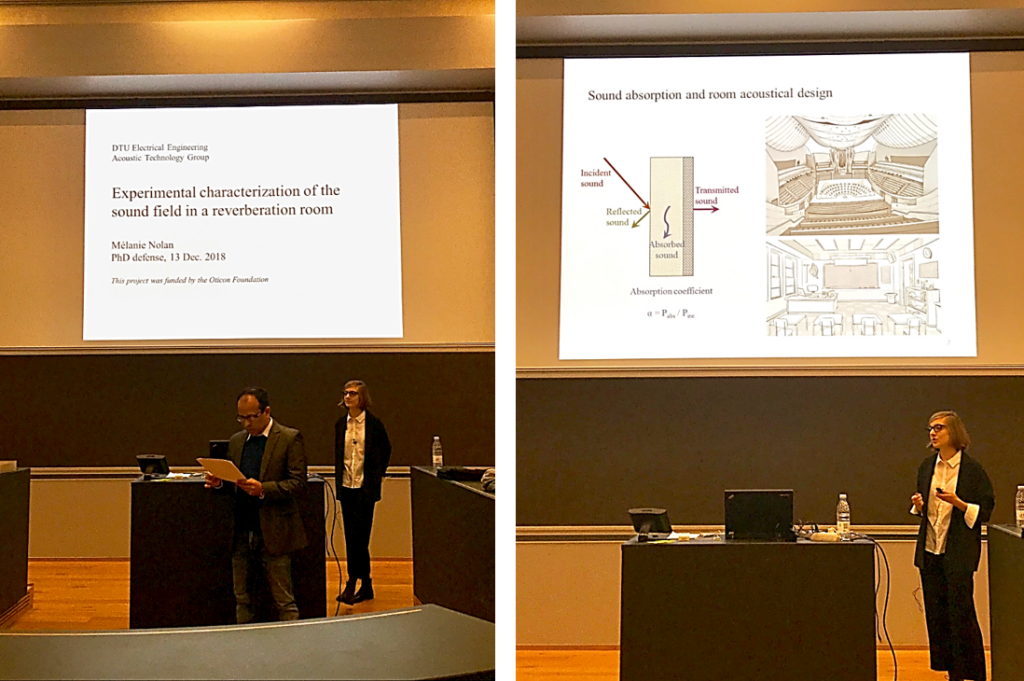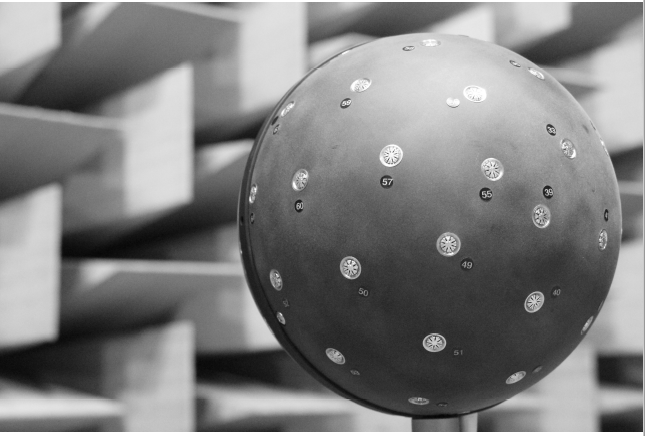
December 13th 2018 we had the privilege to attend a PhD defense at DTU. The work was done by Mélanie Nolan who for the last 3 years has been working intensely to investigate sound fields in the reverberation chamber. This article is touching upon some of the findings from the research.

The influence of absorption
Sound absorption is of decisive influence on the sound field in a room. In room acoustic design, materials are often selected according to their sound absorption properties (i.e., their absorption coefficient) in order to achieve a desired reverberation time, suppress unwanted sound reflections, or reduce the sound pressure level in noisy environments.
Knowledge of the acoustic absorption of building materials is therefore indispensable for many tasks related to room acoustical design, i.e., for predicting the reverberation times in the planning phase of ordinary rooms and performance spaces, or for acoustical computer simulations of these environments.
Testing of material
The main standardized laboratory procedure for measuring the absorption coefficient of a material requires a reverberation chamber, in which a diffuse[*] sound field should be established. In reverberation-room measurements of sound absorption coefficients,1 a large sample of the material under test is placed in the room, and the absorption coefficient is deduced from the resulting reduction of the reverberation time. The procedure is based on the simple reverberation formulae, provided that certain assumptions are verified experimentally. In particular, the validity of these formulae depends critically on the diffusion of the sound field.

Can we rely on the results?
The shortcomings of the measurement procedure have become increasingly evident as a results of numerous round robin tests. Several systematic comparisons of the absorption coefficients determined in a number of standardized laboratories have revealed a significant disagreement in the results, which can be attributed to the different degrees of diffusion established in the various chambers.
Although the reverberation theory has been subjected to criticism since the early 30’s, questioning the validity of the reverberation chamber procedure seems too controversial for the standardization bodies. Instead, considerable experimental effort has been spent on methods for promoting a diffuse sound field. Addition of a number of randomly oriented scattering panels or boundary diffusers was expected to build up diffusion and bring reasonable agreement between laboratories. Yet, there is no evidence that installation of such scattering objects results in “increased diffusion”.3
New methods
Technical developments in sensing methods provide new possibilities for analyzing sound field diffusion in rooms and in recent years, different methods have been proposed for the estimation of diffuseness from measurements with an array of microphones. In particular, spherical microphone arrays can provide a panoramic view of the sound field and are therefore particularly well suited for application where sound waves impinge on the array from multiple directions.

Microphone array processing techniques
In her PhD, Mélanie developed experimental methods allowing for direct observation of the non-diffuse conditions in reverberation chambers used for conventional measurements of sound absorption. Microphone array processing techniques were used to examine the spatial and directional properties of the sound field in a reverberation room, confirming the non-diffuse nature of the sound field. Besides, images of the acoustic energy flows in the vicinity of the absorbing sample could be obtained. Such measurement can be used to analyze the directions of net energy transport, to diagnose biases in specific laboratory configurations, and to examine the diffusing capabilities of various types of diffusing elements. It is anticipated that the proposed experimental framework will be of value in analyzing the disagreement found across standardized laboratories and stimulate research activities in the field.
More information can be found in:
– M. Nolan, E. Fernandez-Grande, J. Brunskog and C.-H. Jeong, “A wavenumber approach to quantifying the isotropy of the sound field in reverberant spaces,” J. Acoust. Soc. Am. 143(4), 2514-2526 (2018)
– M. Nolan and E. Fernandez-Grande, “Volumetric reconstruction of acoustic energy flows in a reverberation room,” J. Acoust. Soc. Am. 145(3), EL203-EL208 (2019)

References
[1] ISO 354:2003, “Measurement of sound absorption in a reverberation room” (International Organization for Standardization, Geneva, Switzerland, 2003)
[2] M. Nolan, M. Vercammen, C.-H. Jeong and J. Brunskog, “The use of a reference absorber for absorption measurements in a reverberation chamber,” Proceedings of Forum Acusticum 2014, Krakow, Poland (2014)
[3] F. Jacobsen, “The diffuse sound field,” Report No. 27, The Acoustics Laboratory, Technical University of Denmark, Kongens Lyngby, Denmark (1979)
_____________
[*] In a diffuse sound field, the time-averaged energy flux is zero at each point and the average energy density is the same everywhere; that is, the sound field is homogeneous and isotropic.

